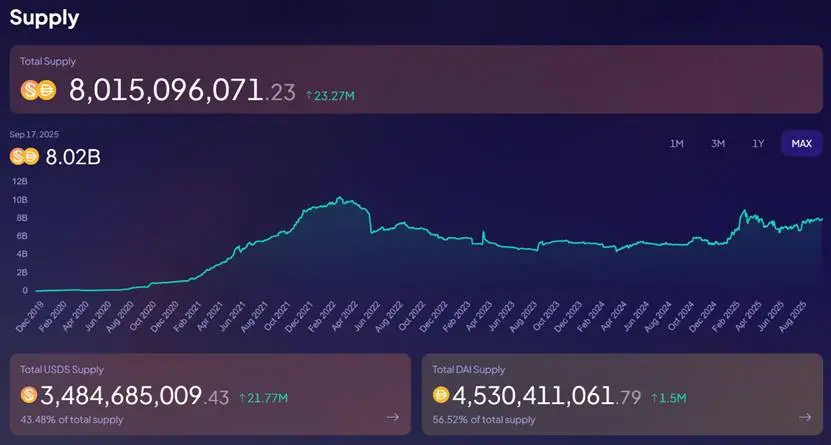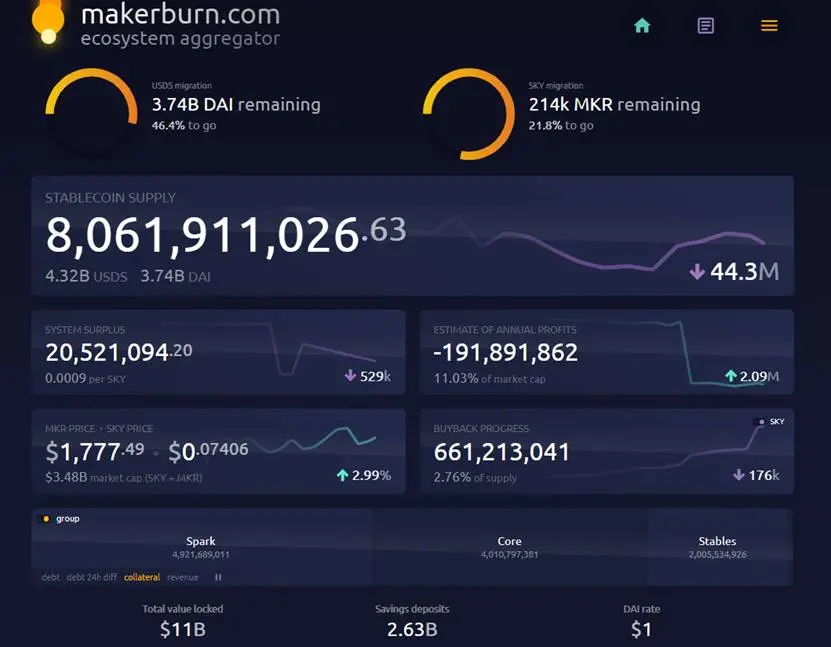Author: Zhou, ChainCatcher
According to public information, Binance completed the token swap, increment, and brand upgrade of Maker (MKR) to Sky (SKY) on September 17, and opened the recharge and withdrawal services for the new SKY token. As of the time of writing, SKY is reported at 0.07414 USDT, with a circulating market cap of approximately 1.72 billion USD and a 24-hour trading volume of about 21.49 million USDT.
At this point in the token swap, the market needs to reassess the narrative and future of the DeFi giant Sky.
Brand and Governance Reconstruction
Sky's predecessor is MakerDAO, a well-established decentralized stablecoin and credit infrastructure. It primarily operates around two mechanisms:
The first is stablecoin and anchoring, which allows for nearly 1:1, low-slippage swaps with custodial stablecoins like USDC through PSM, pulling prices back to target ranges during volatility while providing low-cost entry and exit channels.
The second is interest rates and credit, which form an on-chain capital pricing system through stability fees, savings rates, and liquidation parameters, allowing capital to migrate between protocols and market-making based on interest rates.
This brand and governance reconstruction involves migrating governance from MKR to SKY (1 MKR = 24,000 SKY), upgrading the stablecoin from DAI to USDS, and unifying data and entry points to sky.money. Upgraded users will benefit from core new features, such as native token rewards, where users holding USDS stablecoins can earn SKY governance token rewards through the project's new application, sky.money.
For positions held within exchanges, most replacements are completed automatically in the background; however, for those using self-custody wallets, users need to connect their wallets to the official entry point and call the upgrade contract to complete the exchange (gas fees apply). Users holding DAI can choose whether to exchange it for USDS, and both DAI and MKR will continue to exist as legacy tokens within the renamed Sky protocol.
Financial Core: SSR, MIP65, PSM
Sky's savings annualized rate is seen as an on-chain version of a money market fund rate anchor (SSR). When users hold USDS, depositing into the savings contract will yield a "receipt" sUSDS, with earnings automatically accumulating in the receipt, redeemable at any time for USDS.
For SSR to serve as an anchor, it also needs stable cash flow support. This foundation began with MIP65, which can be understood as an investment authorization: it allows stable assets accumulated through PSM to be compliantly allocated to short-duration U.S. Treasury and investment-grade bonds, forming measurable coupon income.
After entering the Sky phase, the income generated from MIP65 will enter the system surplus, which will then route to savings rates and ecological incentives, linking off-chain coupons with on-chain distribution. This way, SSR does not have to rely entirely on secondary market trading conditions but instead has cross-cycle cash flow support.
Sky's USDS and DAI, along with Aave's GHO, belong to the CDP route of decentralized stablecoins. A Galaxy report indicates that GHO operates based on Aave's lending and liquidation framework, following the "collateral—mint—repay—burn" process; whereas Sky's focus is more on issuing its own CDP stablecoin and anchoring mechanism, leading to differences in parameters and governance paths compared to general lending protocols. The report states that in terms of scale and adjustable space within the CDP route, Sky's system still leads, with GHO, FRAX, and LUSD in a smaller second tier, determining their operational leeway in interest rates/incentives and anchoring.
In terms of scale, Rune stated that Sky is the fourth largest stablecoin project globally. Official data shows that the total amount of Sky stablecoins is approximately 8.062 billion USD, with USDS around 4.32 billion (53.6%) and DAI about 3.74 billion (46.4%). According to makerburn data, Sky's total TVL across the chain is about 11 billion USD, with a system surplus of approximately 20.55 million USD. He also mentioned that Sky's native buyback engine generates 250 million USD in profits annually, currently using 36 million USD each year for SKY token buybacks. This figure is planned to increase to 150 million USD per year and will further grow as Sky's profits continue to rise.


Thickening Cash Flow
Sky Stars is an independent protocol unit relied upon by Maker, aimed at innovating on the fringes outside of Maker DAO. The first Sky Star launched is the Spark protocol, positioned as a lending and capital scheduling layer. According to DeFiLlama statistics, the TVL of the Spark Liquidity Layer is approximately 3.2 billion USD, consistently maintaining above 3 billion.
This year, Spark initiated a tokenization competition to publicly attract up to 1 billion USD of RWA into the Spark ecosystem, with multiple updates confirming the selection of winners and the actual deployment of the 1 billion USD scale of RWA.
Additionally, Sky has also joined the bidding for the issuance rights of USDH from Hyperliquid. Public information shows that Hyperliquid's recent trading volume approached 400 billion USD, with USDC deposits in the platform around 5.5 billion USD, accounting for about 7.5% of the total supply of this stablecoin. Sky promises to provide about 4.85% returns for USDH held on Hyperliquid, with earnings used for HYPE buybacks and assistance funds; simultaneously, it offers about 2.2 billion USD in instant redemption liquidity through PSM, enhancing the ability for institutions to manage large inflows and outflows.
Rune also stated that Sky can commit 25 million USD of USDH to capitalize Hyperliquid Genesis Star and will exclusively custody it on the Hyperliquid blockchain.
These two lines clarify Sky's direction of thickening cash flow support, not only relying on MIP65's own portfolio but also amplifying through external collaborations; over the past year, Sky has also been attempting to bring broader RWA on-chain, such as institutional-level credit, all aimed at thickening the underlying cash flow. Its subsequent expansion will directly impact the growth of USDS (supply side) and the absorption of sUSDS (demand side) slope, thereby reflecting on the stability of SSR and the expected distributable cash flow.
Conclusion
This migration and upgrade of Sky brings governance, stablecoins, and cash flow distribution into a clear main line. How far the narrative can go does not depend on the token swap itself, but on whether governance can enhance user experience, whether cash flow can continue to be accounted for, and whether funds can migrate stably along the interest rate anchor. For traders, rather than betting on a one-time token swap, it is better to focus on the direction and rhythm of these data, as they determine the mid-term pricing space of SKY.
Click to learn about job openings at ChainCatcher
免责声明:本文章仅代表作者个人观点,不代表本平台的立场和观点。本文章仅供信息分享,不构成对任何人的任何投资建议。用户与作者之间的任何争议,与本平台无关。如网页中刊载的文章或图片涉及侵权,请提供相关的权利证明和身份证明发送邮件到support@aicoin.com,本平台相关工作人员将会进行核查。




